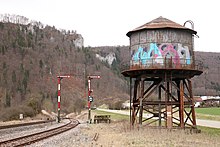water-tank
A natural or artificial storage tank for drinking water or industrial water is called a water reservoir or water reservoir .
The term reservoir is used more for natural storage, but the distinction is not clear in everyday language.
Natural memory
Above ground
Underground
Artificial memory
Reservoirs
Reservoirs are artificially created standing waters that can serve to store water.
Deep tank
The water level of the storage tank is lower than it corresponds to the supply pressure. The water must therefore be pumped up from the container for the supply. Deep tanks are therefore suction tanks for pumping stations and serve to balance between the source inflow or well pre-delivery and the lifting of water into the supply network. In the case of pressure tank pumping stations, they have to take over partial tasks of the elevated tank, such as compensating for fluctuations in consumption or storing the amount of extinguishing water.
Extinguishing water storage

Very often and in small rural communities , the storage is almost always necessary of extinguishing water in particular for firefighters necessary extinguishing water reservoirs, eg. B. if there is no central water supply or the water supply in the elevated tank is insufficient for large fires . Since there are no special hygienic and technical requirements for the water, surface water can also be used for the filling . In general, existing ponds are provided with the facilities required for the extraction of extinguishing water or artificial extinguishing ponds are created. In closed built-up areas, on the other hand, underground extinguishing water tanks are appropriate.
Elevated tank

The water storage in elevated tanks is the most common, and is present in most central water supply systems . It is the water reservoirs or water tanks whose water level is higher than the supply area from which the water flows into the supply network with a natural gradient . They serve to compensate for fluctuations in consumption, to maintain the pressure in the supply network evenly, to provide emergency supplies and to store a water supply for extinguishing purposes, in pipelines and group water supply systems as interruption tanks and zone tanks.
If the elevated tank is arranged at the appropriate height, the intended supply pressure is given. Elevated tanks can possibly be arranged at different heights in order to serve different pressure levels (hilly terrain). However, tanks are not only used to build up water pressure, but also to reduce pressure, especially in supply networks with large differences in height, so-called flow-through containers are used, because otherwise the pressure at the lowest point of the supply network would be too high.
Elevated earth tank
The water reservoir is installed in a location that is favorable in terms of height and location, for the most part under the ground and covered with earth. This form of elevated tank is often sought because it is the most economical and most reliable.
Water tower

Water towers can only store small amounts of water, but due to their geodetic height they provide a corresponding pressure for the pipeline network below. If there is no conveniently located site, the water is stored in the vicinity of the supply area in water chambers that are housed in the upper part of a tower-like structure. Occasionally the water tower is designed as a standpipe tower (water silo), whereby the bottom of the water chamber is the same as the foundation bottom. The costs of a water tower are considerably higher than those of an underground container (around five to ten times). The water level of the storage tank is therefore usually not as high above the supply area as in the case of the high-level reservoir and its capacity is kept smaller.
Surge water tank
In swimming pools there are surge water tanks, also called raw water storage tanks. The name surge water tank came about because z. B. in swimming pools the water gushes over an overflow channel before it arrives in the actual container. The surge water tank is a space in which water can be collected and removed again.
The required usable volume of a raw water storage tank is made up of various proportions, the displacement volume of the bathers, the surge water volume caused by the waves of the bathers, and in many older systems also the flushing water volume that is reserved for the filter flushing . Exact formulas for calculating the individual volumes can be found in Part 1 of DIN 19643 .
literature
- Rosemarie Karger, Frank Hoffmann: water supply. Extraction - processing - storage - distribution, 14th edition, Springer Vieweg, Wiesbaden 2013, ISBN 978-3-8348-1380-0 .
- Willi Gujer: Urban water management . Springer Verlag Berlin Heidelberg, Berlin Heidelberg 1999, ISBN 978-3-662-12992-0 .
- Helmut Damrath: water supply. BG Teubner, Stuttgart 1998, ISBN 978-3-519-15249-1 .
- Mutschmann / Stimmelmayr: Taschenbuch der Wasserversorgung , 16th edition, Springer Vieweg, Wiesbaden, ISBN 978-3-8348-9805-0
See also
- Water distribution system
- irrigation
- Fire water
- Surface water
- drought
- Desertification , desertification , karstification
- Retention basin
Web links
- Seasonal gravel water storage (accessed on March 31, 2016)
- Water storage in transition (accessed on March 31, 2016)
- Stainless steel water storage tank (accessed March 31, 2016)


